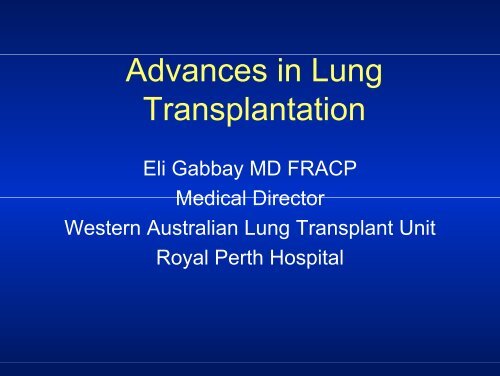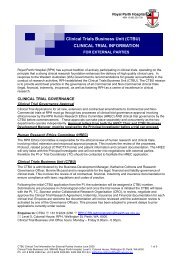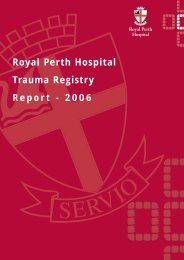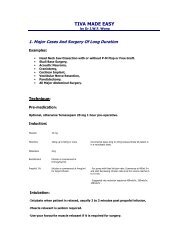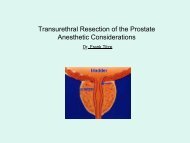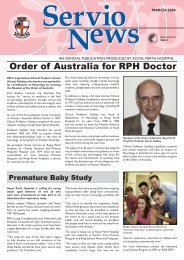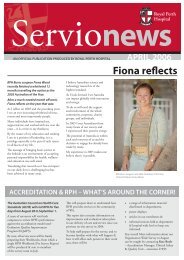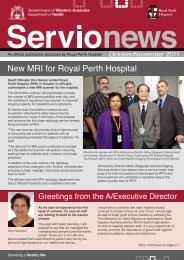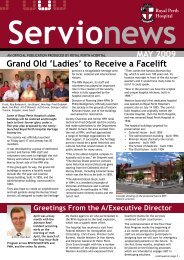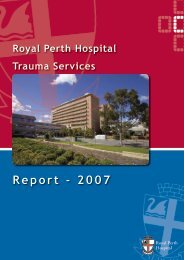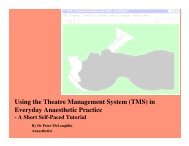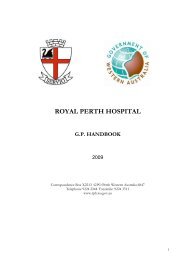Advances in Lung Transplantation - Royal Perth Hospital
Advances in Lung Transplantation - Royal Perth Hospital
Advances in Lung Transplantation - Royal Perth Hospital
Create successful ePaper yourself
Turn your PDF publications into a flip-book with our unique Google optimized e-Paper software.
<strong>Advances</strong> <strong>in</strong> <strong>Lung</strong><br />
<strong>Transplantation</strong><br />
Eli Gabbay MD FRACP<br />
Medical Director<br />
Western Australian <strong>Lung</strong> Transplant Unit<br />
<strong>Royal</strong> <strong>Perth</strong> <strong>Hospital</strong>
Survival for Solid Organ <strong>Transplantation</strong><br />
RPH <strong>Lung</strong>Transplants<br />
RPH Heart Transplants
Why is <strong>Lung</strong> <strong>Transplantation</strong> so<br />
difficult?<br />
“We choose to do these th<strong>in</strong>gs not because<br />
they are easy but because they are hard”<br />
John Fitzgerald Kennedy 1960<br />
– Surgical<br />
– Immediate Post operative (0 -10 days)<br />
– Early Post Operative ( 0 - 90 days)<br />
– Long term (270 days + )
Why is <strong>Lung</strong> <strong>Transplantation</strong> so<br />
difficult?<br />
– Surgical<br />
– Immediate Post operative (0 -10 days)<br />
– Early Post Operative ( 0 - 90 days)<br />
– Long term (270 days + )
Protoplasm<br />
Surgical Issues<br />
– late referral<br />
– prolonged wait (improved with <strong>in</strong>creased donor rates)<br />
Need for pneumonectomy<br />
– bleed<strong>in</strong>g ++<br />
Pleural Space Issues<br />
– <strong>in</strong>fection<br />
–air leak<br />
– need for prolonged <strong>in</strong> situ Intercostal Catheters
Pneumonectomy <strong>in</strong> already scarred lungs and pleura can be<br />
associated with chest wall bleed<strong>in</strong>g that may be difficult to<br />
control
Donor Availability<br />
1. Impact of Donate West<br />
- 1.5 x <strong>in</strong>crease <strong>in</strong> lung donors <strong>in</strong> 5 years<br />
- medical donor co-ord<strong>in</strong>ator at SCGH<br />
- WA second highest organ donation rate<br />
- RPH 3rd busiest hospital <strong>in</strong> Australia<br />
2. Greater Donor Pool<br />
- marg<strong>in</strong>al donors (<strong>in</strong>creased use with local donors)<br />
- impact of non-heart beat<strong>in</strong>g donors<br />
More donors results <strong>in</strong> more transplants at a more<br />
optimal time
Maximiz<strong>in</strong>g the Utilization of Donor<br />
Organs Offered for LTX<br />
Gabbay E et al<br />
Am J of Respiratory and Critical Care Medic<strong>in</strong>e Vol 160 1999<br />
140 transplants<br />
- from January 1st 1995 to May 31st 1998<br />
- from 112 of 219 (51%) lung donor offers<br />
48 (43%) satisfied published criteria for suitable<br />
organ donors (Group 1)<br />
64 (57%) did not (marg<strong>in</strong>al donors Group 2)
Maximiz<strong>in</strong>g the Utilization of Donor<br />
Organs Offered for LTX<br />
Gabbay E et al<br />
Am J of Respiratory and Critical Care Medic<strong>in</strong>e Vol 160 1999<br />
o difference between patients transplanted<br />
from ideal (47%) or marg<strong>in</strong>al donors (53%)<br />
- gas exchange at 24hrs<br />
- length of ICU stay<br />
o difference <strong>in</strong> 30d, 1yr, 2yr and 3yr survival<br />
nly graft ischaemic time predicted recipient<br />
Pa02/Fi02 ratio
Use of Marg<strong>in</strong>al Donors<br />
Marg<strong>in</strong>al donors can be used without<br />
compromis<strong>in</strong>g results from transplantation<br />
provid<strong>in</strong>g the ischaemic time is low<br />
A greater percentage of local marg<strong>in</strong>al donors<br />
were used because ischaemic times were low<br />
Implications for hav<strong>in</strong>g a local program
Why is <strong>Lung</strong> <strong>Transplantation</strong> so<br />
difficult?<br />
– Surgical<br />
– Immediate Post Operative (0 -10 days)<br />
– Early Post Operative ( 0 - 90 days)<br />
– Long term (270 days + )
Ischemic reperfusion <strong>in</strong>jury<br />
Most frequent cause of early mortality and<br />
prolonged ICU stay<br />
Frequency 10-20 %<br />
Risk factors<br />
- ischaemic time<br />
- poor preservation<br />
Characterised by non cardiogenic pulmonary<br />
odema<br />
Histologically characterised by diffuse alveolar<br />
damage
Treatment<br />
Volume status important - keep dry<br />
Ma<strong>in</strong>ta<strong>in</strong> blood pressure with <strong>in</strong>otropic support<br />
Requires max ventillatory support, <strong>in</strong>dependent<br />
lung ventilation (SLTx)<br />
Nitric Oxide - Reduces length of ICU stay<br />
ECMO (extracorporeal membrane oxygenation)<br />
for severe hypoxia
Prevention<br />
<strong>in</strong>imise Ischaemic Time<br />
- Ischaemic times <strong>in</strong> WA are low as most local<br />
donors<br />
prove Organ Preservation<br />
- We are consider<strong>in</strong>g adopt<strong>in</strong>g a low K+<br />
preservation solution
Why is <strong>Lung</strong> <strong>Transplantation</strong> so<br />
difficult?<br />
– Surgical<br />
– Immediate Post Operative (0 -10 days)<br />
– Early Post Operative ( 0 - 90 days)<br />
– Long term (270 days + )
Early Post Operative<br />
Balance between <strong>in</strong>fection and rejection<br />
<strong>Lung</strong> is open to the environment<br />
- recipient lungs are wonderful growth media<br />
- <strong>in</strong>creased risk of <strong>in</strong>fection post transplantation<br />
Large organ, lots of lymphocytes and<br />
receives total cardiac output<br />
- <strong>in</strong>creased risk of rejection<br />
- requires higher levels of calc<strong>in</strong>eur<strong>in</strong> <strong>in</strong>hibitors<br />
- comb<strong>in</strong>ation of greater exposure to <strong>in</strong>fection +<br />
need for higher levels of immunosuppression
Improvements <strong>in</strong> Treatment and<br />
Prevention of Infection<br />
– Cytomegalovirus<br />
– Respiratory Viral Infections<br />
• improvements with ribavar<strong>in</strong> and oseltamivir<br />
– Fungal Infections<br />
• improvements with voriconazole and liposomal<br />
amphoteric<strong>in</strong>
CMV Pneumomitis Post <strong>Lung</strong> Transplant
CMV and <strong>Lung</strong> <strong>Transplantation</strong><br />
CMV disease has important implications<br />
(?unique) to lung transplantation<br />
Incidence pre prophylaxis 53 - 75 %<br />
Highest of any solid organ transplant<br />
D+ / R- 90-100%; D+ / R+ 55 - 60%<br />
Improvements <strong>in</strong> prophylaxis<br />
- reduced rates of <strong>in</strong>fection and disease<br />
- reduced rates of chronic graft dysfunction
Post Transplant CMV Prophylaxis<br />
Zamora et al Am J of <strong>Transplantation</strong> 2004;4:1635<br />
90 Post <strong>Lung</strong> Transplant (donor or recipient CMV<br />
positive)recipients received I.V. Ganciclovir (5<br />
mg/kg/bd, 2weeks) plus CMV Immunoglobul<strong>in</strong><br />
followed by Valganciclovir (450 mg bd) for 180 -<br />
365 days<br />
Compared to 140 historical controls who received<br />
high dose oral Aciclovir <strong>in</strong>stead of Valganciclovir
Post Transplant CMV Prophylaxis<br />
Zamora et al Am J of <strong>Transplantation</strong> 2004;4:1635<br />
Results:<br />
CMV <strong>in</strong>fection: 7.8 % (valgan) v 35%; p
CMV and <strong>Lung</strong> <strong>Transplantation</strong><br />
pre emptive therapy<br />
uantification of Viral Load (and treat based on this)<br />
- CMV Quantitative PCR (serum and lavage)<br />
- CMV antigenemia<br />
arlier treatment of disease if it does develop<br />
- Less severe disease (not see<strong>in</strong>g CMV<br />
pneumonitis)<br />
- ? Delayed development of BOS
Why is <strong>Lung</strong> <strong>Transplantation</strong> so<br />
difficult?<br />
– Surgical<br />
– Immediate Post operative (0 -10 days)<br />
– Early Post Operative ( 0 - 90 days)<br />
– Long term (270 days + )
Improvements Over Time?
Long Term Problems<br />
Thorn <strong>in</strong> the side of lung transplantation<br />
Obliterative Bronchiolitis<br />
(Bronchiolitis Obliterans Syndrome; BOS)<br />
Active
Typical FEV1 Plot<br />
Start of basel<strong>in</strong>e<br />
End of basel<strong>in</strong>e<br />
BOS 1<br />
BOS 2<br />
BOS 3
The real mean<strong>in</strong>g of BOS…<br />
BOS is a late phenomenon<br />
- diagnosed at least a month after the<br />
physiological effect of a particular pathological<br />
event first becomes apparent.<br />
Heal<strong>in</strong>g by secondary <strong>in</strong>tention is already<br />
established<br />
The fibroproliferative response has been active<br />
for (at least) 4-6 weeks!
Anatomy of the Bronchioles<br />
The kill<strong>in</strong>g zone
The real mean<strong>in</strong>g of BOS…<br />
• BOS 0 : 0-20% small airways <strong>in</strong>volved<br />
• BOS 0-p :10-30% small airways <strong>in</strong>volved<br />
• BOS 1 : 20-40% small airways <strong>in</strong>volved<br />
• BOS 2 : 30-50% small airways <strong>in</strong>volved<br />
• BOS 3 : 40-80% small airways <strong>in</strong>volved
Potential therapies<br />
• Corticosteroids<br />
• CNI switch<strong>in</strong>g<br />
• Cytolytic therapies<br />
• Azithromyc<strong>in</strong><br />
• Mycophenolate vs Azathiopr<strong>in</strong>e<br />
• MTOR <strong>in</strong>hibitors<br />
• Radiotherapy<br />
• Surgery (especially for GERD)<br />
multiplicity bespeaks lack of efficacy
CNI Switch from CyA to Tacrolimus:<br />
Demographics<br />
n = 144<br />
M: F = 55: 45<br />
Age = 38 ± 13 (M ± SD)<br />
23%<br />
23%<br />
17%<br />
17%<br />
Indications<br />
Indications<br />
for<br />
for<br />
primary<br />
primary<br />
Tx<br />
Tx<br />
5%<br />
5%<br />
25%<br />
25%<br />
30%<br />
30%<br />
CF COPD/Emphysem Fibrosis PH Others<br />
CF COPD/Emphysem Fibrosis PH Others<br />
Number of p atients<br />
60<br />
50<br />
40<br />
30<br />
20<br />
10<br />
0<br />
55<br />
60<br />
RAR OB Side effects Miscellaneus<br />
arahrudi K, Estenne M, Corris P, Niedermayer J, Knoop C, Glanville AR, Chapparo C et al.<br />
nternational experience with conversion from cyclospor<strong>in</strong>e to tacrolimus for acute and chronic lung allograft rejection.<br />
Thorac Cardiovasc Surg, 2004; 127:1126-1132.<br />
21<br />
8
Switch from CyA to Tacrolimus<br />
Rejection episodes 3 months pre and post switch<br />
Mean of nr. of rejections<br />
2<br />
1.8<br />
1.6<br />
1.4<br />
1.2<br />
1<br />
0.8<br />
0.6<br />
0.4<br />
0.2<br />
0<br />
1.9<br />
0.27<br />
p = 0.001<br />
0.5<br />
RAR OB<br />
prio r to s witc h post switch<br />
p = 0.001<br />
arahrudi K, Estenne M, Corris P, Niedermayer J, Knoop C, Glanville AR, Chapparo C et al.<br />
nternational experience with conversion from cyclospor<strong>in</strong>e to tacrolimus for acute and chronic lung allograft rejection.<br />
Thorac Cardiovasc Surg, 2004; 127:1126-1132.<br />
0.11
hange <strong>in</strong> FEV1 (% pred) after switch from CyA to Tacrolimus<br />
FEV1% predicted<br />
90<br />
80<br />
70<br />
60<br />
50<br />
40<br />
30<br />
20<br />
10<br />
0<br />
FEV1( % pred) - Time course<br />
Mean monthly loss <strong>in</strong><br />
FEV1% = 2.65%<br />
Best value 6 mo. 3 mo. switch 3 mo. 6 mo. 12 mo.<br />
OB RAR Total<br />
Mean monthly loss <strong>in</strong><br />
FEV1% = 1.0%<br />
arahrudi K, Estenne M, Corris P, Niedermayer J, Knoop C, Glanville AR, Chapparo C et al.<br />
nternational experience with conversion from cyclospor<strong>in</strong>e to tacrolimus for acute and chronic lung allograft rejection.<br />
Thorac Cardiovasc Surg, 2004; 127:1126-1132.
CNI Switch<strong>in</strong>g: Conclusions<br />
ecurrent Acute Rejection<br />
Tacrolimus is is highly effective <strong>in</strong> <strong>in</strong> controll<strong>in</strong>g acute rejection. rejection<br />
<strong>Lung</strong> function stabilises over a time time period of of 1 year year<br />
bliterative Bronchiolitis<br />
Tacrolimus results <strong>in</strong> <strong>in</strong> a reduced rate rate of of progression of of OB OB<br />
Influence of of the the natural history of of OB OB is is unknown<br />
ide effects<br />
No No significant difference <strong>in</strong> <strong>in</strong> frequency of of <strong>in</strong>fection or or<br />
impairment of of renal function<br />
Klepetko, et al. JTCVS 2004
Azithromyc<strong>in</strong><br />
Panbronchiolitis and CF model<br />
Early data hold promise<br />
Def<strong>in</strong>itive trial awaited<br />
Multiple mechanisms<br />
- Anti-<strong>in</strong>flammatory<br />
- ? antifibrotic<br />
- Disrupt biofilm <strong>in</strong>tegrity<br />
- Downregulate epithelial IL2
Azithromyc<strong>in</strong>….. Susan G Gerhardt, John F McDyer, Reda<br />
E Girgis, John V Conte, Steve C Yang, Jonathan B<br />
Orens… AJRCCM
SURGERY<br />
Surgery for gastro- esophageal reflux<br />
disease (GERD):<br />
– Effective<br />
Native lung volume reduction for native lung<br />
hyper<strong>in</strong>flation syndrome:<br />
– Effective if transplanted lung does not have OB<br />
– Less effective if does have OB<br />
<strong>Lung</strong> retransplantation:<br />
– Selected patients
Fundoplication for GERD<br />
369 LTx<br />
(Davis et al, JTCVS, 2003;125:533-42)<br />
128 pH probes 93 abnormal<br />
43 fundoplication<br />
pre fundoplication post fundoplication<br />
Number BOS 26/43 13/43<br />
Mean FEV1 1.89L 2.19L<br />
rout<strong>in</strong>e transplant group post surgery group<br />
3yr survival 71% 86%<br />
5 yr survival 48% 69%
OB: New Therapies are Needed<br />
Rationale<br />
Cause<br />
- unknown but associated with recurrent<br />
and severe rejection<br />
Process<br />
- <strong>in</strong>flammation / fibroproliferation<br />
Effect<br />
- endstage <strong>in</strong>tralum<strong>in</strong>al fibrosis
In vitro effect on fibroblasts<br />
from LTX patients..<br />
“Everolimus and mycophenolate mofetil<br />
are potent <strong>in</strong>hibitors of fibroblast<br />
proliferation after lung transplantation.”<br />
Andrea Azzola , Adrian Havryk, Prashant Chhajed, Katr<strong>in</strong> Hostettler, Judith Black,<br />
Peter Johnson, Michael Roth, Allan R Glanville, Michael Tamm<br />
<strong>Transplantation</strong>: 2004; 77:275-280.
Azzola A, Havryk A, Chhajed P, Hostettler K, Black J, Johnson P, Roth M, Glanville AR, Tamm M.<br />
Everolimus and mycophenolate mofetil are potent <strong>in</strong>hibitors of fibroblast proliferation after lung transplantation.<br />
<strong>Transplantation</strong> 2004; 77:275-280.<br />
% Growth +/- SE<br />
150<br />
100<br />
50<br />
-50<br />
0<br />
Effect of Methylprednisolone<br />
on stimulated LTX fibroblasts<br />
0.01 0.1 1 10 50 100<br />
Concentration (mg/l)<br />
Azzola et al
Azzola A, Havryk A, Chhajed P, Hostettler K, Black J, Johnson P, Roth M, Glanville AR, Tamm M.<br />
Everolimus and mycophenolate mofetil are potent <strong>in</strong>hibitors of fibroblast proliferation after lung transplantation.<br />
<strong>Transplantation</strong> 2004; 77:275-280.<br />
% Growth +/- SE<br />
150<br />
100<br />
50<br />
-50<br />
0<br />
Effect of Everolimus (RAD)<br />
on stimulated LTX fibroblasts<br />
� �<br />
1 -05 1 -04 0.001 0.01 0.1 1<br />
Concentration (mg/l)
Azzola A, Havryk A, Chhajed P, Hostettler K, Black J, Johnson P, Roth M, Glanville AR, Tamm M.<br />
Everolimus and mycophenolate mofetil are potent <strong>in</strong>hibitors of fibroblast proliferation after lung transplantation.<br />
<strong>Transplantation</strong> 2004; 77:275-280.<br />
% Growth +/- SE<br />
150<br />
100<br />
50<br />
-50<br />
0<br />
Effect of Mycophenolate mofetil<br />
on stimulated LTX fibroblasts<br />
0.001 0.01 0.1 0.5 1 5<br />
Concentration (mg/l)<br />
�<br />
��
Three Year Analysis of an<br />
International Randomized Study of<br />
MMF vs. Azathiopr<strong>in</strong>e <strong>in</strong> <strong>Lung</strong><br />
<strong>Transplantation</strong><br />
On Behalf of the International Study Group<br />
Trial Sponsored by Roche
MMF<br />
1.5gm bd<br />
159 patients<br />
40 deaths<br />
Survival<br />
75%<br />
317 Patients<br />
Survival<br />
72%<br />
SLT 33%<br />
HLT 11%<br />
BLT 56%<br />
AZA<br />
1-2mg/kg/day<br />
158 patients<br />
48 deaths<br />
Survival<br />
69%
Post-Hoc Analysis of Composite Endpo<strong>in</strong>t:<br />
BOS, Death, ReTx, Withdrawal for Lack of<br />
Therapeutic Response<br />
% Event<br />
100<br />
80<br />
60<br />
40<br />
20<br />
0<br />
p = 0.07<br />
0 0.5 1 1.5 2 2.5 3<br />
Years after Randomization<br />
MMF<br />
AZA
Randomized, double-bl<strong>in</strong>d study of<br />
everolimus<br />
vs AZA to <strong>in</strong>hibit the decl<strong>in</strong>e of<br />
pulmonary function <strong>in</strong> stable lung<br />
&<br />
heart-lung transplant recipients<br />
- 24 month results -<br />
On behalf of the RAD B159 Study Investigators
imary composite efficacy endpo<strong>in</strong>t<br />
Month 12<br />
Everolimus AZA<br />
(n=101) (n=112) p-value<br />
Primary composite endpo<strong>in</strong>t: 21.8% 33.9% 0.05<br />
- Decl<strong>in</strong>e <strong>in</strong> FEV1 >15% 15.8% 27.7% 0.03<br />
- Graft loss 1.0% 5.4% 0.06<br />
- Patient death 3.0% 8.9% 0.06<br />
Month 24<br />
Primary composite endpo<strong>in</strong>t: 43.6% 44.6% ns<br />
- Decl<strong>in</strong>e <strong>in</strong> FEV1 >15% 34.7% 41.1% ns<br />
- Graft loss 7.9% 8.0% ns<br />
- Patient death 12.9% 13.4% ns
Steer<strong>in</strong>g Committee of the Australian<br />
and European Investigators<br />
<strong>in</strong> <strong>Lung</strong> <strong>Transplantation</strong>
<strong>Lung</strong> <strong>Transplantation</strong><br />
at <strong>Royal</strong> <strong>Perth</strong> <strong>Hospital</strong>
Actuarial survival post lung<br />
transplantation (1992 - 2006)<br />
RPH ISHLT Alfred<br />
1 month 98% (n = 68) 88% 94%<br />
1 year 91% (n = 53) 77% 90%<br />
2 year 85% (n = 41) 68% 78%<br />
3 year 82% (n = 35) 61% 73%<br />
5 year 77% (n = 16) 47% 69%<br />
10 year 66% (n = 5) 22% 44%
RPH First 8 Transplants<br />
Who have we done?<br />
patients <strong>in</strong> 13 months (target 8 / year first 2 yrs)<br />
edian wait<strong>in</strong>g time 8 weeks<br />
- Australian median 11 months<br />
SLTx, 1 Ht-<strong>Lung</strong> Tx, 2 BSLTx (7 M; median age 59, range<br />
45 - 64)<br />
- 4 emphysema, 3 ILD (1 pt both), 1 alpha 1<br />
antitryps<strong>in</strong><br />
all hypoxic and hypercapnoeic, functional class IV<br />
- 1 congenital heart disease/ PAH<br />
LV and RV failure, functional class IV, implantable
RPH First 8 Transplants<br />
How have they done?<br />
median ischaemic time 3.0 hrs (range 2 - 5 hrs),<br />
3/7 non-ideal donors resulted <strong>in</strong> 4/8 transplants<br />
Post operative ventilation 2 - 18hrs (median 9 hrs)<br />
ICU stay 1 - 4 days (median 2 days)<br />
1 death, day 16, wound dehiscence<br />
1 re<strong>in</strong>tubation for 12 hours at day 21<br />
median <strong>Hospital</strong> stay 27 days (14 - 44 days)<br />
7 alive, functional class I -II, nil requirement for<br />
supplemental oxygen<br />
median 6MWT improvement 215 metres (75 - 345 m)


